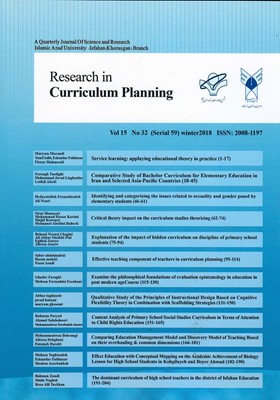Identifying and categorizing the issues related to sexuality and gender posed by elementary students
Subject Areas : Research in Curriculum PlanningHedayatallah Etemadizadeh 1 * , Ali Nouri 2
1 - faculty member of education department, University of Malayer, Hamedan, Iran.
2 - faculty member of education department, University of Malayer, Hamedan, Iran.
Keywords: sexuality, Curriculum, gender, Sexual education,
Abstract :
The present study conducted to identify and categorize the issues related to sexuality and gender posed by elementary students through a mixed method research in two phases. In the first phase, the critical issues were identified and consequently classified employing an action research design by participation of elementary school educators of Malayer. The second phase was conducted in order to prioritize and rank the derived issues using a questionnaire survey which responded by 169 elementary teachers. The data from the first phase of study resulted in identifying 50 questions classified into the 5 categories including relations and interaction with others, social values and norms with respect of sexuality and gender, educational and cultural context, developmental bases, sexual behavior, reproduction and pregnancy. According to the results of category ranking, the category of relations and interaction with others was ranked as the first priority and the category of sexual behavior, and reproduction and pregnancy as the last priority.
Abolghasemi, Narya., MerghatiKhoei, Efatossadat. & Taghdissi, MohammadHussein. (2010). Teachers' perceptions of sex education of primary school children. 8 (2):27-39 [Persian].
Amini, Mohammad., Tammanaeifar, MohammadReza & Pashaei, Roghayeh. (2011). Sexual Education in Iranian High School Curricula. Article 7, Volume 1, Issue 1, Summer and Autumn, Page 169-202 [Persian].
Berk, Laura. E .(2014). Development through the lifespan. Boston: Pearson. Trans Into Farsi by: SeyedMohammadi, Y, (2016). Tehran Arasbaran Publishing House [Persian],
Cresswell, J.W. (2003). Research Design: Qualitative, quantitative and mixed methods approaches. London: Sage.
Debesse, Maurice. (1952). Les étapes de l'éducation. Édition. Paris Presses universitaires de France. Trans Into Farsi by: Kardan, A. (1995). Tehran University Press.
Ebrahimi Harestani, Asghar A., Mahram, Behrouz., Liaghatdar, Mohammadjavad. (2015). The Analysis of Null Curriculum in Sex Education: Focusing on the Male Students at Junior High School. Research in Curriculum Planning. Vol 12. No 17(continus) 44 Spring 2015, 26-40 [Persian].
Eisenberg, M., Sieving, R., Oliphant, J., & Resnick, M. (2010). Teachers’ perspectives on sexuality education: Final report. The Healthy Youth Development.
Eisner, E.W. (1994). The Educational Imagination (third edition).Macmillan College Publishing Company: New York.
Johnson, R.B. & Onwuegbuzie, A.J. (2004). Mixed methods research: A research paradigm whose time has come. Educational Researcher, 33(7), 14-26.
Kontula, O. (2010).The evolution of sex education and students’ sexual knowledge in Finland in the 2000s. Sex Education, 10 (4), 373–386.
McKee, C., Ragsdale, K., Southward, L. (2014). What do parents in Mississippi really think about sex education in schools? Results of a state-level survey. Journal of Health Disparities Research and Practice, 7(1), 97-119.
Mehrmohammadi, Mahmoud. (2000). Rethinking the Teaching - Learning Process and Teacher Education, Tehran: Madreseh Publishing House [Persian].
Miller, John. P. (1983). The educational spectrum: Orientations to curriculum. New York: Longman. Chicago. Trans. Into Farsi by: Mehrmohammadi, Mahmoud. (2000), Tehran: Samt Publishing House [Persian].
Nouri, Ali. & Khadijeh Sadat Mousavi. (2016). Students’ sexual education as the moral responsibility of schools. Paper presented in the first national conference on professional ethics in educational systems. Malayer University, May 5, 2016 [Persian].
Nouri, Ali. & Mohamadi, Younes. (2016). Practical Guide to Research in the Humanities. Tehran: Virayesh [Persian].
Pokharel, S., Kulczycki, A. & Shakya, S. (2006). School-based sex education in western Nepal:
uncomfortable for both teachers and students, Reproductive Health matters, 28, 156-161.
Saif, Ali-Akbar. (2007). Modern educational psychology: The psychology of learning and instruction, Terharn: Virayesh Publishing Co [Persian].
Schunk, D.H. (2012). Learning theories: An educational perspective (6th edition). Pearson Education, Inc.
Short, Edmound .C. (1991). Forms of curriculum inquiry. Albany, N.Y.: State University of New York Press. Trans. Into Farsi by Mehrmohammadi, M. (2008). Tehran: Samt Publishing House [Persian].
Shykhavandi, Davar. (2006). The Reflection of Gender Identities in Social Science Textbooks of Elementary and Guidance Schools. Quarterly Journal of Education. Fall 2006, Volume 22, Number 3 (87); 93 -120 [Persian].
Smith, M. K. (2006). Development of a K – 3 Sexuality Education Curriculum, A Senior Honors Thesis Presented in Partial Fulfillment of the Requirements for graduation with distinction in Human Development and Family Science in the College of Human Ecology at The Ohio State University.
Sobhaninejad, Mehdi., Hommaei, Reza. & Aelleien, Hamid. (2007). Analytic investigation of families’ sexual education styles of Tehran. Counseling Research, 6 (21), 27-48 [Persian].
Unesco. (2009). International Technical Guidance on Sexuality Education: An evidence-informed approach for schools, teachers and health educators. Unesco.
Zohrehvand, Raziyeh. (2006). Gender – Sensitive Education as Reflected in the Educational Planning of the Public School System. Quarterly Journal of Education. Fall 2006, Volume 22, Number 3 (87); 147 -174 [Persian].
_||_
